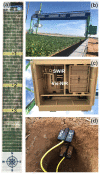A New Optical Remote Sensing Technique for High-Resolution Mapping of Soil Moisture
- PMID: 33693360
- PMCID: PMC7931970
- DOI: 10.3389/fdata.2019.00037
A New Optical Remote Sensing Technique for High-Resolution Mapping of Soil Moisture
Abstract
The recently developed OPtical TRApezoid Model (OPTRAM) has been successfully applied for watershed scale soil moisture (SM) estimation based on remotely sensed shortwave infrared (SWIR) transformed reflectance (TRSWIR) and the normalized difference vegetation index (NDVI). This study is aimed at the evaluation of OPTRAM for field scale precision agriculture applications using ultrahigh spatial resolution optical observations obtained with one of the world's largest field robotic phenotyping scanners located in Maricopa, Arizona. We replaced NDVI with the soil adjusted vegetation index (SAVI), which has been shown to be more accurate for cropped agricultural fields that transition from bare soil to dense vegetation cover. The OPTRAM was parameterized based on the trapezoidal geometry of the pixel distribution within the TRSWIR-SAVI space, from which wet- and dry-edge parameters were determined. The accuracy of the resultant SM estimates is evaluated based on a comparison with ground reference measurements obtained with Time Domain Reflectometry (TDR) sensors deployed to monitor surface, near-surface and root zone SM. The obtained results indicate an SM estimation error between 0.045 and 0.057 cm3 cm-3 for the near-surface and root zone, respectively. The high resolution SM maps clearly capture the spatial SM variability at the sensor locations. These findings and the presented framework can be applied in conjunction with Unmanned Aerial System (UAS) observations to assist with farm scale precision irrigation management to improve water use efficiency of cropping systems and conserve water in water-limited regions of the world.
Keywords: OPTRAM; TERRA-REF; high-resolution; precision irrigation; remote sensing; soil moisture.
Copyright © 2019 Babaeian, Sidike, Newcomb, Maimaitijiang, White, Demieville, Ward, Sadeghi, LeBauer, Jones, Sagan and Tuller.
Figures






References
-
- Babaeian E., Sadeghi M., Franz T. E., Jones S., Tuller M. (2018). Mapping soil moisture with the OPtical TRApezoid Model (OPTRAM) based on long-term MODIS observations. Remote Sens. Environ. 211, 425–440. 10.1016/j.rse.2018.04.029 - DOI
-
- Babaeian E., Sadeghi M., Jones S. B., Montzka C., Vereecken H., Tuller M. (2019). Ground, proximal and satellite remote sensing of soil moisture. Rev. Geophys. 57, 530–616. 10.1029/2018RG000618 - DOI
-
- Burnette M., Willis C., Kooper R., Maloney J. D., Ward R., Shakoor N., et al. . (2018). TERRA-REF data processing infrastructure, in Proceedings of the Practice and Experience on Advanced Research Computing (Pittsburgh, PA: ). 10.1145/3219104.3219152 - DOI
-
- Effati M., Bahrami H.-A., Gohardoust M. R., Babaeian E., Tuller M. (2019). Application of satellite remote sensing for estimation of dust emission probability in the Urmia Lake Basin in Iran. Soil Sci. Soc. Am. J. 83, 993–1002. 10.2136/sssaj2019.01.0018 - DOI
-
- Entekhabi D., Njoku E. G., O'Neill P. E., Kellogg K. H., Crow W. T., Edelstein W. N., et al. . (2010). The soil moisture active passive (SMAP) mission. Proc. IEEE. 98, 704–716. 10.1109/JPROC.2010.2043918 - DOI
LinkOut - more resources
Full Text Sources
Research Materials

